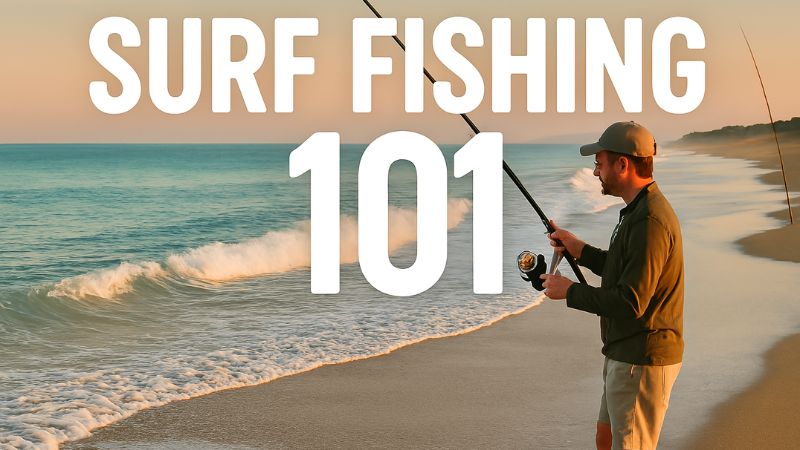Surf Fishing 101: Best Rigs, Baits & Beaches for Success
Why Surf Fishing is the Ultimate Shore Adventure
There’s something addictive about standing on the shoreline, feeling the sand shift under your feet while the ocean plays its endless rhythm. Surf fishing brings the fight to your door — no boat needed, no pier ticket, just you, your rod, and the wild surf.
This beginner surf fishing guide is built for anyone curious about how to surf fish or ready to level up their skills. Whether you want to chase pompano along the Gulf, go for striped bass in the Northeast, or pull in whiting on the Pacific, we’ll cover the surf fishing rigs and baits, the best beaches for surf fishing, and practical surf fishing tips that work.
Understanding Surf Fishing Basics
What is Surf Fishing?
At its core, surf fishing means casting from shore into the sea’s feeding lanes. Unlike pier fishing, which gives you height, or boat fishing, which takes you directly over reefs, surf fishing requires reading the water, knowing how waves interact with the beach, and presenting bait where fish naturally hunt.
You’ll be dealing with sandbars, troughs, and rip currents, learning to cast past the breaker line using a surf casting rod — typically longer than average rods to reach further.
Key Advantages of Surf Fishing
- Accessibility: All you need is a beach and your setup — it’s one of the easiest forms of saltwater fishing from shore to start.
- Species variety: Depending on your location, you might hook pompano, bluefish, whiting, striped bass, red drum, or even flounder.
- Low equipment barrier: With a simple surf fishing rod and reel setup and a few proven rigs, you can get going without needing thousands in gear.
Essential Safety Tips Before You Start
- Reading tides & weather: Always check a weather forecast for fishing and be aware of tide changes. Some areas flood fast on an incoming tide.
- Protective gear: Waders help in cold water, and sun protection is a must. Polarized sunglasses help you spot fish and read the water.
- Local regulations: Secure your fishing license and know the saltwater regulations for size and bag limits. Respect catch‑and‑release for non‑target species.
The Best Surf Fishing Rigs for Beginners
Fish Finder Rig
Best for: Larger predators like striped bass and red drum.
Setup:
- Thread a pyramid sinker or sputnik sinker on your main line.
- Attach a swivel.
- Add a leader line for surf fishing (mono or fluorocarbon) with a circle hook baited with squid, cut mullet, or live bait.
Why it works: The sliding sinker lets the bait move naturally, which helps fool wary fish.
Pompano Rig (Double Drop Rig)
Also called: Double‑drop rig
Best for: Pompano, croaker, whiting.
Setup: Two short dropper lines above the sinker, each with hooks and bright beads or floats.
Tip: Mix sand flea bait on one hook and shrimp bait surf on the other to see what’s getting more hits.
Carolina Rig
Use for: Calm surf or when fish are holding close to structure.
Setup:
- Egg sinker above a swivel
- Long leader with hook
- Works great for artificial lures for surf like soft plastics or with live bait surf fishing.
💡 Pro Gear Tip: For all rigs, choose leader material based on water clarity. Monofilament line is affordable and forgiving, while braided fishing line offers sensitivity and strength. Keep shock leaders handy for casting heavy sinkers.
Choosing the Right Baits
Live Baits
- Sand flea (mole crab) — Top choice for pompano.
- Shrimp (live and frozen) — Great for most inshore species.
- Finger mullet — Perfect for targeting bigger predators.
Pros: Natural scent and movement increase hookups.
Cons: Need to keep alive or fresh.
Cut Baits
- Cut mullet, squid strips, clam meat
- Best during surf fishing in rough water when scent travels further.
Artificial Lures
- Metal spoon — Fast retrieve attracts bluefish and mackerel.
- Soft plastic bait — Mimics small baitfish or shrimp.
- Topwater plug — Exciting strikes at dawn and dusk.
Technique: Vary retrieve speeds, watch for strikes between wave sets.
Finding the Perfect Beach
How to “Read” a Beach
Knowing where to cast can be more important than what you throw. Look for:
- Sandbars: Fish patrol along the edges.
- Troughs: Deeper runs between shore and sandbar are natural feeding lanes.
- Rip currents: Fish along the edges where bait is swept out.
Timing Your Trips
- Best tide for surf fishing: Often the incoming tide, but local behavior matters.
- Dawn surf fishing and dusk can produce aggressive bites.
- Moon phase fishing tips: New and full moons affect tidal currents and feeding activity.
Example Destinations
- East Coast Surf Fishing: Outer Banks (North Carolina), Cape Cod (Massachusetts)
- Gulf Coast Surf Fishing Tips: Florida Panhandle, Padre Island (Texas)
- Pacific Coast Surf Fishing: Huntington Beach (California), Cannon Beach (Oregon)
Pro Tips for Surf Fishing Success
- Rod & reel maintenance: Always rinse with fresh water to prevent salt damage.
- Pack smart: Keep essentials — rigs, spare line, bait, pliers — in a waterproof bag.
- Fishing log: Record species identification, tide stage, bait used, and results.
Common Mistakes to Avoid
- Using hooks or leaders too large or too small for your target species.
- Ignoring local bait patterns — match the hatch for best results.
- Standing in water too deep to feel bites — sometimes fish are just a few feet from shore.
Conclusion & Call to Action
You now know how to read a beach, pick the right surf fishing rigs and baits, and time your sessions for maximum chances of success. Start with your nearest shoreline, practice your surf casting techniques, and keep refining. The ocean rewards patience, awareness, and adaptability.
If you’ve got your own surf fishing tips or a favorite rig setup, share it — because fishing wisdom grows when it’s passed along.
FAQs
1. What’s the best bait for pompano?
Sand flea bait is often the top choice, but small shrimp or clam strips can work when fleas aren’t available.
2. How do I choose the right sinker for surf fishing?
In strong waves, a pyramid sinker surf or sputnik sinker holds better. In calm water, egg sinkers or lighter weights work.
3. Can I use artificial lures for surf fishing?
Yes — metal spoons, soft plastic bait, and topwater plugs can be deadly when fish are feeding actively.
4. What’s the best tide for surf fishing?
Many anglers prefer incoming tide fishing because bait and fish move closer to shore, but learn your local pattern.
5. Do I need a fishing license for surf fishing?
Yes, in most regions you need a valid fishing license and must follow saltwater fishing regulation guidelines.
6. How do I read rip currents for fishing?
Look for darker water channels moving seaward between breaking waves. Fish along the sides, not in the center.
7. What’s in a surf fishing tackle list for beginners?
A surf casting rod, spinning reel, sinkers, rigs, spare line, swivels and snaps, hooks, bait, pliers, and a rod holder/sand spike.
8. Is surf fishing at high tide worth it?
Yes, especially if high tide aligns with dawn or dusk, as fish tend to roam closer then.
9. Which locations are surf fishing hotspots in the U.S.?
Outer Banks, Cape Cod, Florida Panhandle, Padre Island, Huntington Beach, Cannon Beach are all proven.
10. What’s the safest way to fish in rough surf?
Stay shallower than knee‑deep, use a firm stance, wear a wading belt, and watch incoming wave sets constantly.

